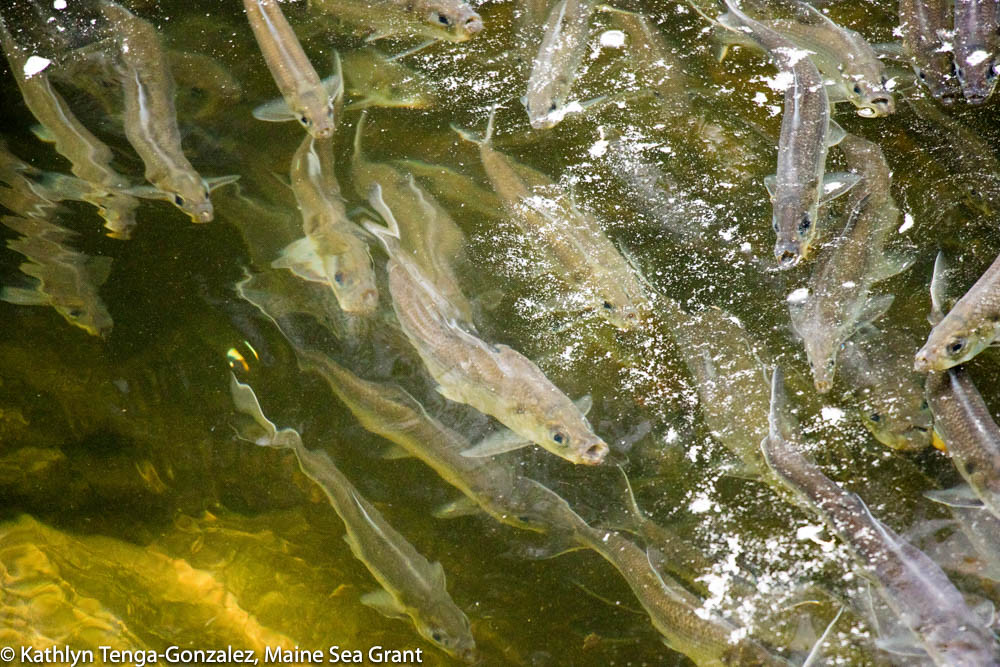Maine Seafood Guide – Alewife

Species Description
Season
Status
Regulatory Authority
Harvest Method
Recreational Harvest
Health Benefits & Risks
Buying & Preparing
Brands
Certifications
Links
►Species Description
Alewife Alosa pseudoharengus
Blueback herring Alosa aestivalis
also known as river herring, gaspereau, sawbelly, kyak
Wild.
Alewife and blueback herring are members of the herring family, which also includes shad. Alewife, blueback herring, and shad are collectively called “river herring,” but should not be confused with the Atlantic herring, which is strictly a marine fish. Alewife and blueback herring look very similar: silvery on the side but blue or purplish when viewed from the top, looking down into the water where they pack tightly on their upstream migration. They are sea-run or anadromous species: each spring, they return from the ocean to freshwater rivers to spawn, alewives in lakes and blueback herring in rivers.
►Season
April-June
►Status
As with most other species of sea-run or anadromous fish, alewife and blueback herring populations are much depleted from their historic levels and are the focus of habitat restoration efforts coastwide. Maine rivers have some of the healthiest and largest runs, some of which support commercial fisheries (primarily for lobster bait). Alewife populations in some watersheds are supported by stocking adult fish taken from nearby rivers. The Atlantic States Marine Fisheries Commission is currently assessing coastwide population status.
On August 12, 2013, NOAA Fisheries announced that listing river herring under the Endangered Species Act as either threatened or endangered was not warranted. The agency is working with the ASMFC to develop and implement a dynamic conservation plan to help restore river herring throughout its Atlantic coastal range.
►Regulatory Authority
The Department of Marine Resources, as well as those coastal municipalities with rights to river herring resources, cooperatively manage harvests on individual rivers. Each town must submit an annual harvesting plan to DMR for approval that includes measures to assure conservation of the resource.
The Atlantic States Marine Fisheries Commission oversees management of the coastwide population.
►Harvest Method
Alewives and blueback herring are harvested by hand as they ascend freshwater streams and rivers, with weirs, seines, cast nets, and dip nets.
►Recreational Harvest
Yes, up to 25 fish per person per day with dip net or hook-and-line, 6:00 a.m. Sunday to 6:00 a.m. Thursday (fishery closed Thursday through Saturday). Recreational harvesting is not allowed in streams with commercial harvesting leases, unless specifically stated in their management plan.
►Health Benefits & Risks
Alewife and blueback herring are similar to Atlantic herring (sardines) and are good sources of protein and omega-3s. Use caution when eating, as alewife and blueback herring contain numerous small bones.
►Buying & Preparing
A few harvesters smoke alewives and blueback herring, which may be available locally. (Sometimes called “bloaters.”) Jess’s Market in Rockland carries smoked alewives in season.
Here’s an article with recipe from The Portland Press Herald.
►Companies, Brands, and Labels
None.
►Certifications & Verifications
None.
►Links
- More on alewives and blueback herring from the Department of Marine Resources
- Alewife Harvesters of Maine
- Alewife info from Downeast Salmon Federation
- Alewives: Feast of the Season, an article from Maine Boats, Homes & Harbors Magazine (PDF, 996 kb)
- Watch the alewife run at the Damariscotta Mills Fish Ladder
- Read about river herring in The Run by John Hay.
